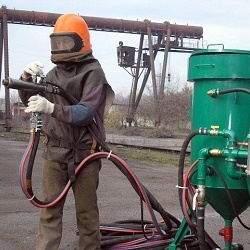How to repair a car pump with your own hands
A car compressor is a device that has noticeably simplified the tire inflation process, which has traditionally been carried out using a hand or foot pump. This unit can operate in automatic mode, has a compact size, and tire inflation with it does not require the use of physical effort. Although the autocompressor does not have a complex structure, some of its components may eventually fail. To repair the device yourself, you need to have an idea of how it works and on what principle it works.
Content
Device and principle of operation of compressors
Compressors for pumping wheels are of the membrane type and piston. Both types of devices are designed to compress air and differ not only in design, but also in the principle of operation.
Membrane Apparatus
If you look at the device of an automobile membrane-type compressor, you can understand that the main element of the unit with which air is compressed, is the membrane. It is made of either rubber or metal.
The membrane autocompressor consists of the following elements:
- an electric motor that drives the drive of the compressor unit;
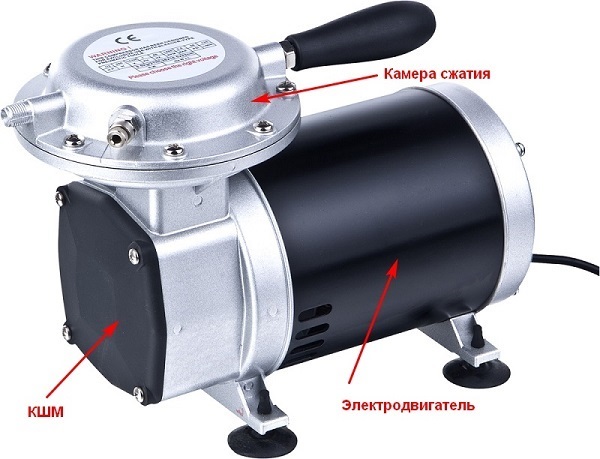
- compression chambers on which 2 valves are installed;
- a rubber, polymer or metal membrane located in the compression chamber;
- rod connecting the piston to the membrane;
- a piston connected to a rod and a connecting rod;
- connecting rod and crank;
- crankcase, which houses the crank mechanism (KSHM).
Autocompressor works on the following principle. The crank converts the rotation of the drive shaft into reciprocating motion of the connecting rod. The one connected to the piston sets it in motion.The piston, moving up and down, sets the diaphragm in motion with a rod. Moving down, the membrane creates a vacuum in the compression chamber, so that the inlet valve opens. When you open the last chamber is filled with air. Moving up, the membrane causes the inlet valve to close, and the process of air compression begins. When a certain degree of compression is reached, the exhaust valve opens, after which the air under pressure enters the hose connected to the tire. When the diaphragm moves downward, a vacuum is again created in the chamber, from which the exhaust valve closes and the inlet valve opens. Further, the entire process described above is repeated.

Important! Due to the fact that the compression chamber is hermetically separated from the crankcase, the air at the exit from the apparatus does not have any impurities. In addition, in the membrane units, air leakage through the glands or piston rings is excluded, which positively affects the performance of the autocompressor.
Piston units
In apparatus for pumping piston type tires The main part is the piston.
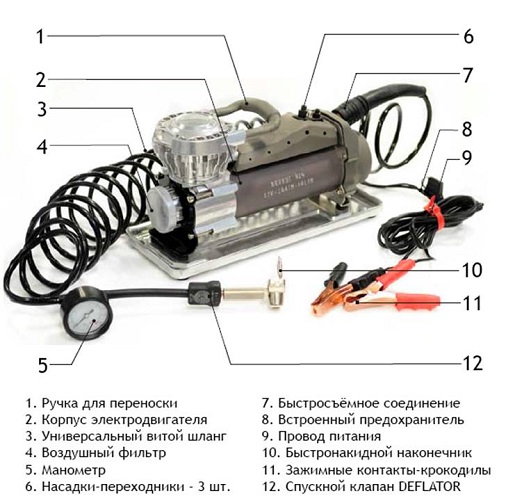
This type of the automobile pump consists of the following knots and details:
- the electric motor driving the drive of the apparatus;
- compression chambers (cylinder) with inlet and exhaust valves;
- air filter;
- a piston having an o-ring;
- KSHM consisting of a rod and a crank;
- crankcase, which houses the crank;
- pressure gauge, which is designed to control the pressure level in tires and can be mounted on a cylinder or hose.
The machine works as follows. The crank wheel is driven either by gear transmission or direct drive. It converts the rotational movements of the drive shaft into reciprocating, which causes the piston to move up and down. The piston, moving downward, creates a vacuum in the cylinder, as a result of which the intake valve opens. Air passing through the filter and the opened valve enters the cylinder. Due to the upward movement of the piston, the air in the cylinder is compressed. When a certain level of pressure is reached in the compression chamber, an outlet valve opens, through which air leaves the apparatus. Further, as the piston moves down, the exhaust valve closes and the intake valve opens and the cycle repeats.
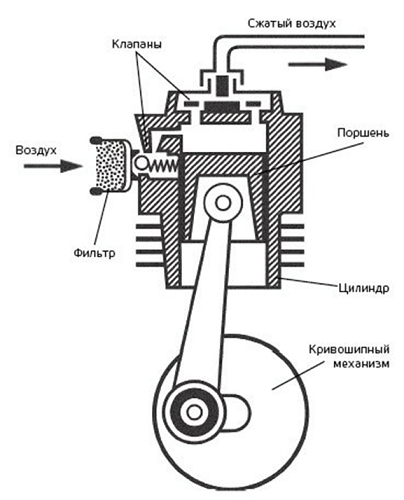
Common problems with reciprocating compressors
Since the design of membrane autocompressors differs significantly from the piston device, some failures of these devices will be characteristic only of a certain type of aggregates.
The most common malfunctions of piston autocompressors that can be eliminated with your own hands include the following:
- the device does not turn on;
- the engine of the unit works, but does not pump air;
- the apparatus does not create the necessary pressure;
- the compressor spontaneously turns off.
The device does not turn on
Compressors for tire inflation have power cable (s) for connection to a power source of 12 V. Some models of devices are connected to the cigarette lighter of the car, and some - to the battery.
If the pump does not turn on, first check the power cables for damage.. They can be called by the tester. Also, if the compressor is connected to the cigarette lighter, then check fuse integrityinstalled in the plug. In case of a blown fuse, it should be replaced.
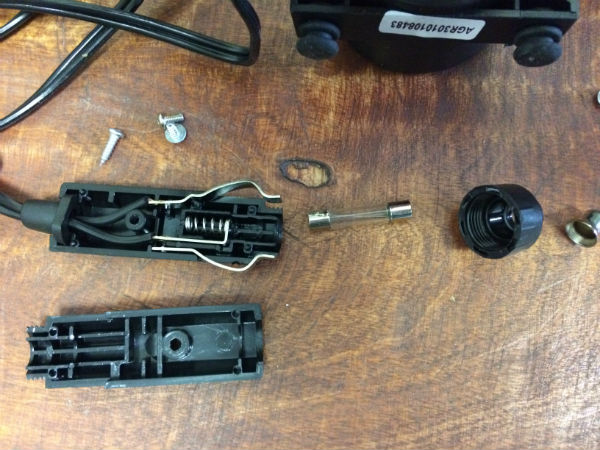
In extreme cases, the device may not turn on due to motor failure. Most often, the motor windings burn out due to overheating. It is easier to buy a new autocompressor, since the repair of the engine of a car compressor will cost 80% of the cost of a new unit.
The engine of the unit works, but the air does not pump
If when you turn on the device you hear the sound of the engine running, but air does not come out of the hose, then in order to diagnose the unit, will have to disassemble it:
- loosen the 4 screws holding the crankcase cover;
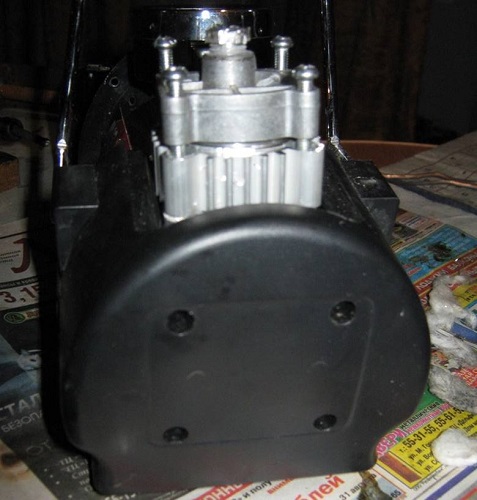
- Also, unscrew the 4 screws installed on the piston head;
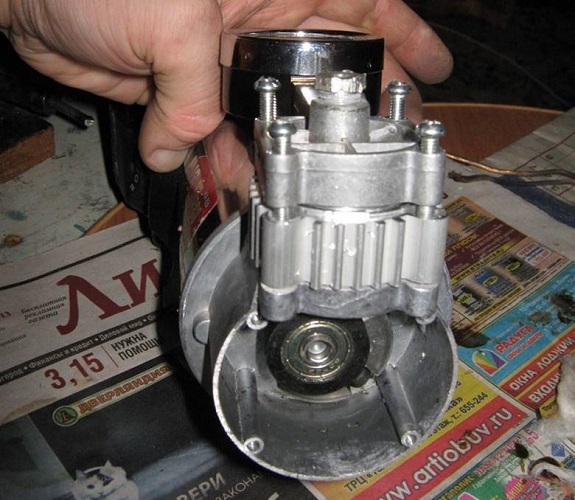
- remove the cylinder head.
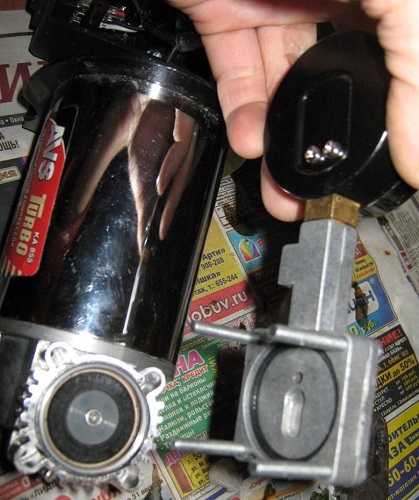
A valve is installed in the cylinder head, which is a frequent reason that the device does not pump. To eliminate the malfunction, it is necessary to remove the seal and the disc with valve from the piston head.
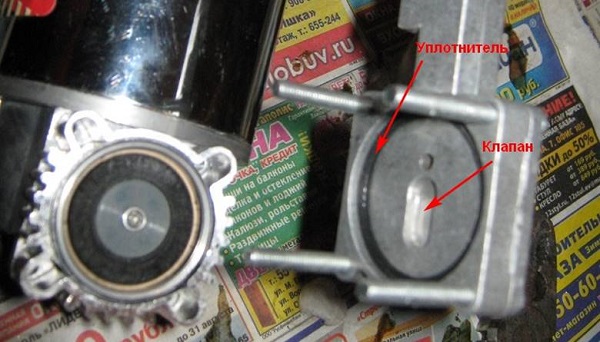
Under the valve is a small sealing ringwhich can wear out over time.When it is worn, the valve is not tight and lets air through. As a result, the compression of the latter does not occur. Also sometimes this ring can move from its seat. If this happens, the valve will also not be able to close. Often the valve plate just breaks. In this case, it must be replaced. This item, like other parts, can be purchased at online stores.
Another reason that the device does not pump may be loose screwwith which the crank is attached to the motor shaft.

If the screw is unscrewed, the motor shaft will rotate, and the crank wheel will remain stationary.
The machine does not create the necessary pressure.
If trying to inflate tires fails to achieve the necessary pressure, then the cause of the problem can be, as in the previous case, valves. Below them can accumulate various contaminants that interfere with good fit. To repair a tire booster compressor, you will need to disassemble the piston head and clean all the parts well from the accumulated dirt.
Sometimes insufficient air pressure at the inlet of the unit can be due to deformation of the sealing ringdressed on a piston.

To remove the piston, you need to remove the sleeve shirt and the sleeve itself.
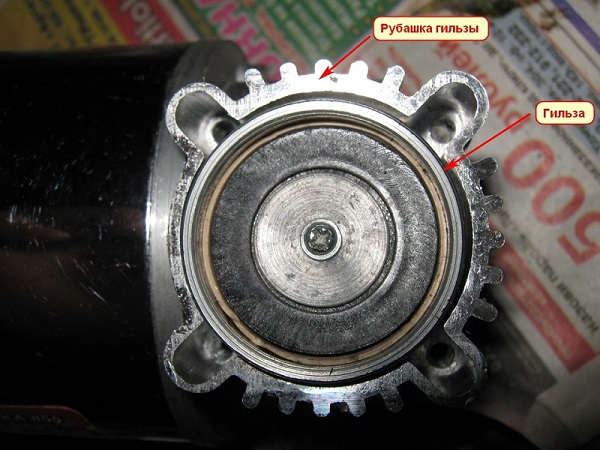
Piston O-ring may deform due to overheating of the unit. To align the ring, it must first be softened. Either solvent 646 or liquid WD-40 can be used for this purpose. After the ring is soft and pliable, it should be aligned, install the sleeve and shirt in place. Check whether the piston moves in the sleeve, you can, if you rotate the engine shaft.
The compressor spontaneously turns off
Some autocompressor models have overheating protection. For this reason, the device and can turn off spontaneously, for example, during prolonged operation. But overheating of the unit can also be caused by a factory fault, especially in low-cost models. There is a flaw in bad fit of the sleeve of the apparatus to the shirt. In this case, heat removal from the piston unit is reduced and, as a result, the piston head and the engine are overheated.
In this case, the repair of the automotive pump will be to eliminate the gap between the sleeve and the jacket (you can use thin sheet aluminum or thermal grease).Thin sheet aluminum can be “mined” by cutting an ordinary beer can. Aluminum need to wrap the sleeve, and tightly insert it into the shirt. After these actions, the heat transfer will improve, and the compressor will stop spontaneously shut off.
Malfunction of membrane autocompressors
Membrane autocompressors extremely rarely break. Although they are characterized by some damage inherent in piston devices: damage to the power cable or blown fuse in the plug, which serves to connect to the cigarette lighter.
But still, the main element of the tire inflation machine, which can fail, is membrane. Most often, it is made of rubber or other plastic material, which at low temperatures coarsens and becomes inelastic. If such an autocompressor is turned on at a low ambient temperature, the membrane will simply tear.. In this case, the repair of the automotive compressor of this type will be to replace the membrane.
How to change the pressure gauge in the compressor
Replacing the pressure gauge on a car compressor will be required if it fails.This measuring device can be installed separately from the unit, on a hose, or on a cylinder head.

If the gauge shows incorrect values or does not work at all, unscrew it, and buy similar, with the corresponding thread and scale.
In some cases, finding the right device can be difficult. To get out of this situation is simple: purchase a pressure gauge for a car compressor and tee with matching thread. Attach a pressure gauge with a tee to the end of the hose, as shown in the following photos.



/rating_off.png)








